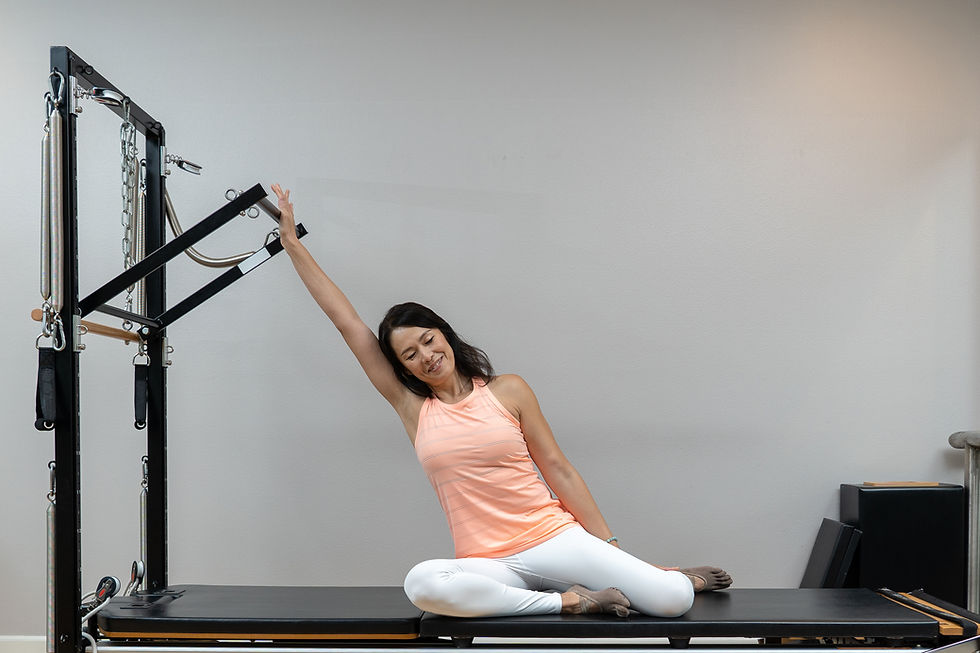Exploring the Benefits of Yoga and Pilates for Pelvic Health
- thepelvicot
- May 24, 2024
- 3 min read

Pelvic health is a critical aspect of overall well-being that often goes overlooked until problems arise. Issues such as incontinence, pelvic pain, and pelvic organ prolapse can significantly impact daily life. Incorporating yoga and Pilates into pelvic health occupational therapy can offer a holistic, non-invasive approach to managing and improving these conditions. This blog post explores the benefits of yoga and Pilates for pelvic health, highlighting specific poses and exercises that can help.
Benefits of Yoga and Pilates for Pelvic Health
Strengthening Pelvic Floor Muscles: Both yoga and Pilates emphasize core strength, which includes the pelvic floor muscles. Strengthening these muscles can help alleviate incontinence and support pelvic organs.
Improving Flexibility and Mobility: Gentle stretching and movement in yoga and Pilates can improve flexibility and mobility in the pelvic region, reducing discomfort and enhancing function.
Enhancing Posture and Alignment: Good posture supports pelvic health by ensuring that pressure is distributed evenly across the body. Yoga and Pilates both focus on alignment, helping to prevent and alleviate pelvic pain.
Reducing Stress and Tension: The mindful nature of yoga and Pilates promotes relaxation and reduces stress, which can positively affect pelvic health. Stress often exacerbates pelvic floor dysfunction, so managing it is crucial.
Promoting Body Awareness: Increased body awareness helps individuals recognize and engage their pelvic floor muscles correctly, improving control and function.
Yoga Poses for Pelvic Health
Child's Pose (Balasana):

Benefits: Stretches the lower back and hips, promoting relaxation and releasing tension in the pelvic area.
How to Do It: Kneel on the floor, sit back on your heels, and stretch your arms forward while lowering your torso to the ground. Hold for several deep breaths.
Bridge Pose (Setu Bandhasana):

Benefits: Strengthens the glutes, lower back, and pelvic floor muscles.
How to Do It: Lie on your back with your knees bent and feet flat on the floor, hip-width apart. Lift your hips toward the ceiling while squeezing your glutes and engaging your pelvic floor. Hold for a few breaths, then lower down slowly.
Malasana (Yogi Squat):
Benefits: Opens the hips and stretches the pelvic floor muscles.
How to Do It: Stand with your feet slightly wider than hip-width apart, toes pointing out. Lower into a squat, keeping your heels on the ground and bringing your palms together at your chest. Hold for several breaths.
Cat-Cow Pose (Marjaryasana-Bitilasana):

Benefits: Improves spinal mobility and gently massages the pelvic floor.
How to Do It: Start on your hands and knees. Inhale as you arch your back (Cow Pose), and exhale as you round your spine (Cat Pose). Repeat for several breaths.
Pilates Exercises for Pelvic Health

Pelvic Tilts:
Benefits: Strengthens the lower abdominal muscles and pelvic floor.
How to Do It: Lie on your back with knees bent and feet flat on the floor. Gently tilt your pelvis towards your ribs, flattening your lower back against the floor. Release and repeat.
The Hundred:
Benefits: Strengthens the core, including the pelvic floor.
How to Do It: Lie on your back with your legs lifted and bent at a 90-degree angle. Lift your head and shoulders off the mat, extend your arms by your sides, and pulse your arms up and down while breathing in and out for a count of five each. Complete 100 pulses.
Side-Lying Leg Lifts:
Benefits: Strengthens the pelvic stabilizing muscles and improves hip mobility.
How to Do It: Lie on one side with your legs straight. Lift the top leg up and down slowly, keeping your core engaged. Repeat on the other side.
Incorporating Yoga and Pilates into Pelvic Health Occupational Therapy

Integrating yoga and Pilates into pelvic health occupational therapy can be highly effective. Here are a few tips for incorporating these practices:
Start Slow: Begin with basic poses and exercises, gradually increasing intensity as the client becomes more comfortable and their strength improves.
Focus on Breath: Encourage mindful breathing to enhance relaxation and ensure proper muscle

engagement.
Customize the Routine: Tailor exercises to each individual’s needs, considering any specific pelvic health issues they may have.
Encourage Consistency: Regular practice is key to seeing improvements. Encourage clients to incorporate these exercises into their daily routine.
By incorporating yoga and Pilates into pelvic health occupational therapy, clients can benefit from a holistic approach that enhances physical strength, flexibility, and overall well-being. These practices not only address the symptoms of pelvic floor dysfunction but also promote a healthier, more balanced lifestyle.

コメント